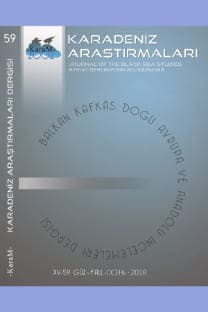Barışı Koruma Sürecinde İnsanî Müdahalenin Rolü (Güney Kafkasya Bölgesinde İnsanî Müdahale İhtiyacı)
Özet Beşeri müdahale, bir devletin başka bir devlete karşı askeri güç kullanması olarak tanımlanır. Beşeri müdahalenin hiçbir yasal – insanî tanımı yoktur. Analiz konusu (hukuk, ahlak, siyaset gibi), bazen seçilen tanımlamayı etkilemektedir. Tanımlamadaki farklılıklar, müdahale edilen devletin rızasının olup olmadığı, insani müdahalenin cezalandırma eylemleriyle sınırlandırılıp sınırlandırılmadığı ve insani müdahalenin sadece Birleşmiş Milletler Güvenlik Konseyi’nin otoritesi altında yürütülen vakalarla ilgili olup olmadığına bağlı değişkenleri içermektedir. Barış koruma, barışın devamı için gerekli şartları yaratmayı amaçlayan faaliyettir. Hem barışı koruma hem de barışı oluşturma çabasından ayrıdır.
Anahtar Kelimeler:
Uluslararası, müdahale, çatışma, enerji, kararlılık, diplomasi, statüko, bütünlük, egemenlik, meslek
The role of Humanitarian Intervention in the Peacekeeping Process (The Necessity of Humanitarian Intervention in the South Caucasus Region)
Humanitarian intervention refers to a state using military force against another state. There is no one standard or legal definition of humanitarian intervention; the field of analysis (such as law, ethics, or politics) often influences the definition that is chosen. Differences in definition include variations in whether humanitarian interventions is limited to instances where there is an absence of consent from the host state; whether humanitarian intervention is limited to punishment actions; and whether humanitarian intervention is limited to cases where there has been explicit UN Security Council authorization for action. Peacekeeping is an activity that aims to create the conditions for lasting peace. It is distinguished from both peace-building and peace-making.
Keywords:
International, intervention, conflict, energy, stability, diplomacy, status quo, integrity, s,
___
- DOROTA Gierycz (2010), “From Humanitarian Intervention to Responsibility to Protect”, Criminal Justice Ethics, 110-128.
- DOWNS George W. – STEDMAN, Stephen John (2002), “Evaluating Issues in Peace Implementation”, Ending Civil Wars: The Implementation of Peace Agreements, Ed. Cousens, Elizabeth M., Donald S. Rothchild and Stephen John Stedman, eds. Boulder, CO: Lynne Reiner Publishers.
- FREEDMAN Lawrence (2001). “Interventionist Strategies and the Changing Use of Force”, Turbulent Peace: The Challenges of Managing International Conflict, Ed. Hampson, Fen Osler, Chester A. Crocker and Pamela Aall, eds. Herndon, VA: USIP Press.
- GOLTZ Thomas (1998), Azerbaijan Diary: A Rogue Reporter's Adventures in an Oil-Rich, War-Torn, Post-Soviet Republic. New York: M.E. Sharpe.
- HAASS, Richard N. (2001), “Using Force: Lessons and Choices for U.S. Foreign Policy”, Turbulent Peace: The Challenges of Managing International Conflict, Ed. Crocker, Chester A., Fen Osler Hampson and Pamela Aall, eds. Washington, D.C.: United States Institute of Peace Press.
- PATTISON James (2010). Humanitarian Intervention and the Responsibility to Protect: Who Should Intervene?, Oxford: Oxford University Press. WELSH Jennifer M. (2004). Humanitarian Intervention and International Relations. Ed. Jennifer M. Welsh. New York: Oxford University Press, HILPOLD, Peter (2002), “Humanitarian Intervention: Is there a Need for a Legal Reappraisal”, European Journal of International Law, 12: 4374
- HOFFMAN Stanley (2001). “The Debate About Intervention”, Turbulent Peace: The Challenges of Managing International Conflict. Ed. Hampson, Fen Osler, Chester A. Crocker and Pamela Aall, eds. Herndon, VA: USIP Press.
- Human Rights Watch/Helsinki (1994). Azerbaijan: Seven Years of Conflict in Nagorno-Karabakh. New York: Human Rights Watch.
- ISSN: 2536-5126
- Yayın Aralığı: Yılda 4 Sayı
- Başlangıç: 2004
- Yayıncı: Osman Karatay
Sayıdaki Diğer Makaleler
Codex Cumanicus'ta Alt Anlamlılık (Hyponymy)
Son Dönem İç ve Dış Politik Gelişmeleri Işığında Türk-Ermeni İlişkileri
1903 Makedonya’sında Reformlara Tepkiler: Manastır Rus Konsolosu Aleksandır Rostkovski’nin Katli
Barışı Koruma Sürecinde İnsanî Müdahalenin Rolü (Güney Kafkasya Bölgesinde İnsanî Müdahale İhtiyacı)
Batı Türklüğü ve Halk İnanmalarının Mitolojik Kök Hücreleri -1.
